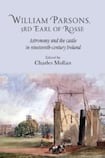
In March and April 1845 William Parsons, 3rd Earl of Rosse, together with his collaborators, made the greatest scientific discovery in the history of Ireland. He discerned the spiral structure of the M51 nebula. Until that turning point in the history of astronomy, a nebula (Latin: cloud) was a mysterious and hotly debated blotch in the heavens: now this one began to be seen as a vast and beautiful cluster of stars, one among many. We live in such a galaxy and we are still peering into deep space to find others.
Fast forward to the present. The 7th Earl and his wife have worked tirelessly to preserve the heritage of Birr Castle. His ancestor’s great telescope has been repaired, a Science Centre established and excellent facilities provided for the public (whom the 3rd Earl already made welcome in his own time). An observatory for radioastronomy has been opened within the demesne, placing it once again at the frontier of cosmology.
Surely this is a perfect time to publish a comprehensive account of the life and times of William Parsons, with distinguished contributions from various hands. They view him from every angle, scientific, political and personal, together with his talented wife and children. A masterful chapter by Wolfgang Steinecke places Parsons very precisely in the progress of the great debate on nebular theories.
His story is one of heroic accomplishment in unlikely circumstances: its climax coincided almost exactly with the cataclysm of the Famine, placing him in a position of great responsibility. He discharged it well. This juxtaposition is so dramatic one cannot help hoping for a further publication, in the form of a great historical novel. What latter-day Trollope will provide it? All the raw material is to hand – add some more personal detail, and stir.
The Leviathan was not particularly original: it was a reflecting telescope of the kind that William Herschel had used to great effect in England. But in astronomy bigger is almost always better, and Birr’s six-foot mirror, itself a technological masterpiece, set new standards in the amount of light it collected. The more you collect, the more you can see, even in the cloudy midlands.
It did not always work well and was condemned by sceptics, but its crowning achievement stood the test of time in the face of criticism. Moreover this book documents an impressive record of observations over many years: too much has been made of the difficulties of operating the great machine satisfactorily.
In addition to indulging his passion for astronomy, managing his estates, coping with his many official roles within the county, and serving in parliament, this energetic Victorian found time to play influential roles in various associations, including the Royal Society. He became its president at just the time when the government was contemplating its first ever grant for private scientific research. His influence can be seen in its implementation – it leaned towards astronomy and the pressing problem of coping with large amounts of data, in an age of observation. In another episode he deplored the failure of the government to adequately support Charles Babbage’s construction of calculating machines. It all sounds familiar today: we still hunger for more computational power.
Denis Weaire is emeritus professor in the school of physics at Trinity College Dublin. He is scientific adviser to the board of Birr Scientific and Heritage Foundation











